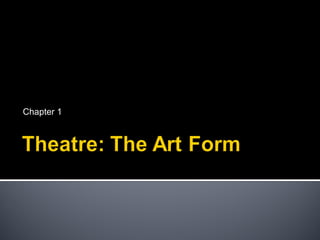Weitere ähnliche Inhalte
Ähnlich wie Chapter one theatre the art form power point (7)
Mehr von ProfessorGraham (7)
Chapter one theatre the art form power point
- 2. A Historical Reason to Attend Theatre
Theatre is the foundation of all drama
▪ Ancient Greeks established the categories of
tragedy and comedy
▪ Roman domestic comedies were the prototype of
situation comedy
Seeing a performance means taking part in
theatre history
© 2013 The McGraw-Hill Companies, Inc. All Rights Reserved. 2
- 3. Theatre incorporates profound,
provocative, timeless observations about
the human condition
Theatre is an art form with its own
characteristics:
Quality
Coherence
Integrity
© 2013 The McGraw-Hill Companies, Inc. All Rights Reserved. 3
- 4. What Is Art?
Characteristics of Art
▪ A mirror or reflection of life
▪ An extension or a projection of how we live, think,
and feel
▪ It reveals to us what we treasure and admire and
what we fear most deeply
▪ It may be an absolute necessity for human survival
© 2013 The McGraw-Hill Companies, Inc. All Rights Reserved. 4
- 5. What Is Art? continued
Characteristics of the Performing Arts
▪ Literary
▪ Novels, short stories, poetry
▪ Visual
▪ Painting, sculpture, architecture, photography
▪ Performing
▪ Theatre, dance, opera, music
© 2013 The McGraw-Hill Companies, Inc. All Rights Reserved. 5
- 6. The Art of Theatre
Elements of Theatre
▪ Audience
▪ Performers
▪ Script or Text
▪ Director
▪ Theatre Space
▪ Design Elements
© 2013 The McGraw-Hill Companies, Inc. All Rights Reserved. 6
- 7. © 2013 The McGraw-Hill Companies, Inc. All Rights Reserved. 7
- 8. The Art of Theatre continued
Theatre as a Collaborative Art
▪ The various elements of theatre must be brought
together and coordinated by a host of people—
collaboration!
© 2013 The McGraw-Hill Companies, Inc. All Rights Reserved. 8
- 9. Nationsand cultures influence one
another’s theatrical traditions
Global connections were rare prior to the
1800s
Theatre can no longer be easily classified by
specific national designations
▪ Beginning around 1900, Asian and other non-
European theatres were influenced by
developments of modern theatre in the West
© 2013 The McGraw-Hill Companies, Inc. All Rights Reserved. 9
- 10. Nationsand cultures influence one
another’s theatrical traditions continued
Theatre is a global activity
▪ Interaction
▪ Adaptation
▪ Collaboration
© 2013 The McGraw-Hill Companies, Inc. All Rights Reserved. 10
- 11. Types of theatre are wide-ranging
Audiences are diverse
Diversity in Contemporary Theatre
Contemporary theatre is:
▪ Complex
▪ It mirrors the society in which it is produced
▪ It is fragmented and reflects the complexity of
today’s life
© 2013 The McGraw-Hill Companies, Inc. All Rights Reserved. 11
